#Obsolete Recordings
Explore tagged Tumblr posts
Text
Various Artists — Solstice: A Tribute to Steffen Basho-Junghans (Obsolete Recordings)

Steffen Basho-Junghans
Solstice: A Tribute to Steffen Basho-Junghans by Various Artists
Steffen Basho-Junghans was a master of the steel string guitar, born in East Germany but finding a spiritual home in the geographically indeterminant blend of folk, blues and raga of the Takoma School. Like Robbie Basho, whose name he appended to his, Basho-Junghans could play in a spare, contemplative style or conjure eddies and cascades of orchestra complexity. His work was always crystal clear and precise, but it evoked something beyond the notes themselves, a mystery and transcendence.
Basho-Junghans died last December, and so Buck Curran, who is also a devotee and practitioner of the Takoma style, brought together an international group of guitarists to pay tribute. His Solstice follows the same format as homages to Jack Rose (Ten Years Gone: A Tribute to Jack Rose) and Robbie Basho (We are All One, In the Sun: A tribute to Robbie Basho and Basket Full of Dragons: A Tribute to Robbie Basho Vol II). These are not covers, but rather free-flowing meditations on Junghans-Basho’s art and influence, with different artists emphasizing different elements of his work.
Curran himself opens and closes the disc with two mournful, contemplative versions of “Winter Solstice.” He plays both cuts on a 12-string guitar that once belonged to Robbie Basho, and that, indeed, featured on all of his records from 1965 to 1986. The guitar, however, needs some serious repair. Curran’s slow, considering approach, where each bent note gets the space to hang and decay, may be partly down to the instrument. In an email, he confided, “[It’s] only possible to play the first few frets, open notes/open harmonics and play slide with it (as I did on my recordings).” The two cuts are, nonetheless, very beautiful, both excellent examples of the rewards of working within limitations.
Many of the other artists on this 22-track collection will be familiar to fans of this Fahey-influenced style of playing. Joseph Allred lets the mountain air (and a few birdcalls) into his exploration of Basho-Junghans’ raga blues in “An Upper Cumberland Raga,” while Isasa, from Spain, lets the space between notes speak in the lovely “Paseo por el Alto Tajo.” In “Every Blue,” Nick Jonah Davis finds tranquility in limpid slides, while Boston’s Robert Noyes rambles and jangles against a bowed note drone in “Surmises.”
The most revealing tracks, though, are the ones that depart furthest from what you expect. Henry Kaiser’s “Requiem for Steffen Basho-Junghans” jars a full set of strings into discord. It sounds like a piano after it’s dropped a couple of feet, ringing with disgruntled dissonance. E. Jason Gibbs plays guitar like a percussion instrument, letting abrupt squeaks and squawks mark out unsettling intervals of time. And Bhajan Bhoy’s “I Can See the Lights of Heaven” interpolates 78-record crackle, bell-like guitar cadences and actual bells, into a chiming, luminous soundscape that opens to the numinous just as Basho-Junghans’ work often did.
Altogether, it’s a lovely tribute, but also absolutely its own thing. It may help to know Basho-Junghans’ music, or to be familiar with the participating artists, but it’s not necessary. So, use Solstice to honor Basho-Junghans if you already admire him. Or put it on to explore how forward-thinking guitar players are extending his vision around the world. It’s also a way to help out since some of the proceeds from Solstice will go to Basho-Junghans family. All good reasons to check in. What are you waiting for?
Jennifer Kelly
#Steffen Basho-junghans#solstice#obsolete recordings#jennifer kelly#albumreview#dusted magazine#guitar#takoma school#buck curran
3 notes
·
View notes
Text
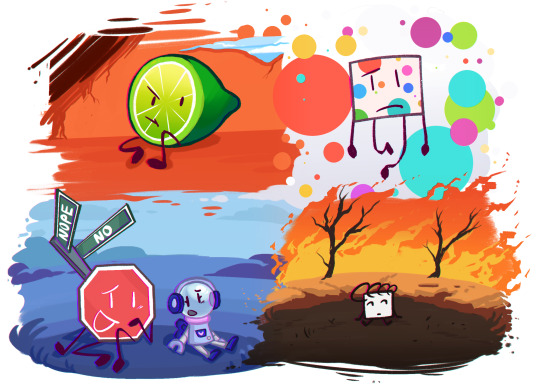
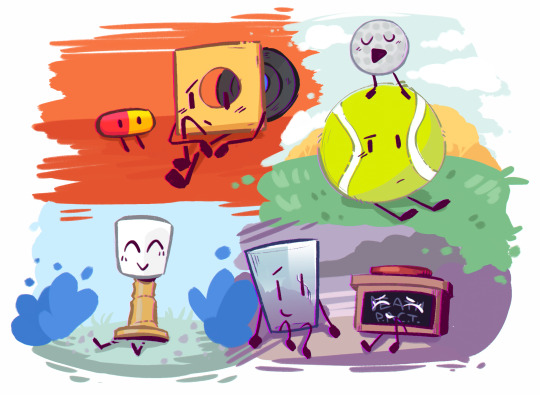
Tha silly critters from tha shows,,,
#auuhg time to tag everything okay...#osc fanart#osc art#burner fanart#burner limey#burner record#burner pilly#itft fanart#its time for the#itft no way#itft polka dot#itft wind-up toy#the nightly manor fanart#tnm sketchpad#animatic battle fanart#ab doorstopper#bfdi fanart#bfdi golf ball#bfdi tennis ball#obsolete battle show#obs cup#obs buzzery#that's alot of funny funny guys!!!#can you tell which of these sets were drawn first (and was drawn at like... 4 am.....) lol#might make a dedicated post with just show hosts and stuff later cuz those are my favorites everytime#KD'sCrumbs#TheTrinketShelf!
88 notes
·
View notes
Text
in my experience most young kids today know what DVDs are but are unfamiliar with CDs. if they're into horror they'll know what tapes of all varieties are, and may even be familiar with floppy discs- but if they're not into horror they usually have only heard of VHS, if that. most don't know what an mp3 is but they're sorta generally unfamiliar with all files types now (that's a horrifying reality for another day) so i'm not shocked. they absolutely know what a vinyl record is
#mine#this makes sense to me even if i feel old#the popularity of analog horror and 80s-90s nastolgia makes obsolete formats known#but CDs are i guess totally irrelevant to children now#most homes seem to still use DVDs at least a little#and 40yo ex-hipsters and taylor swift has made sure records stick around
36 notes
·
View notes
Photo

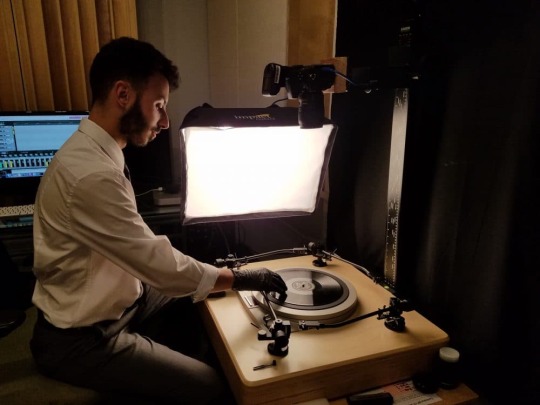
(via Internet Archive Responds to Recording Industry Lawsuit Targeting Obsolete Media | Internet Archive Blogs)
Statement from Brewster Kahle, digital librarian of the Internet Archive:
“When people want to listen to music they go to Spotify. When people want to study 78rpm sound recordings as they were originally created, they go to libraries like the Internet Archive. Both are needed. There shouldn’t be conflict here.”
These preservation recordings are used in teaching and research, including by university professors like Jason Luther of Rowan University, whose students use the Great 78 collection as the basis for researching and writing podcasts for use in class assignments (University Professor Leverages 78rpm Record Collection From the Internet Archive for Student Podcasts, June 9, 2021). While this mode of access is important, usage is tiny—on average, each recording in the collection is only accessed by one researcher per month.
The recording industry truly are a bunch of greedy morons that don’t give a fuck about music or the artists who create it...
just MONEY for themselves
110 notes
·
View notes
Text
It’s bizarre but true: wire recording is the longest-lasting capture format in audio history, one that paved the way for reel-to-reel tapes and a host of others—even though most people today, and some techies included, have barely heard of it.
Invented way back in 1898 and patented two years later, wire recording was somehow still getting some limited use as late as the early 1970s, while rockets took man to the moon on an annual basis. In its wake, vinyl, with its 67 years, and CD with a mere 33, look like footling youngsters. In its none-too-brief life, "the wire" also found use in Hollywood, provided a broadcast aid to spying, helped launch digital data capture, and pioneered the new art of bootlegging—sorry, "home recording."
59 notes
·
View notes
Text
#📼.dizzy#obsolete tech#technically not a recording from a vhs tape#but holy shit check out this fucked up screen i saw in a bus#aesthetic#glitch
2 notes
·
View notes
Text
Ive made this animatic burner humanized on youtube, Check em out!
Animatic here
#milkart#osc#art#fanart#object shows#object show community#sacriverse#sacristuff#obsolete battle show#burner#burnerosc#5sos3#battle for grandma#bfg#kit burner#hanger burner#record burner#paint roller 5sos#lava lamp obs#marshie art#tissue burner#milkdraw#burner osc#burner object show
24 notes
·
View notes
Text
if i told you guys i made a 30 minute game review/game design analysis on ieytd2 in comparison to the first one would you believe me and follow up quastion would you still love me if i told you that was over a year ago and i never actually finished it
#ieytd#i got all the audio down but fuck if i know how to capture good visuals with the quest 2 dude. it sucks so bad.#WHY DOES IT ONLY RECORD IN 6:6 WITHOUT A CABLE. ITS A QUEST 2. THE LACK OF CABLES IS THE APPEAL.#been feeling very demotivated recently with the release of the third game on the rise#i'm obviously incredibly excited but it also feels like a countdown to the day half a year's progress becomes obsolete#and even if i *did* get good quality recordings theres no guarantee my fiddly computer or editing software won't ruin it another way#it is what it is i guess. but its still demoralizing. makes me regret taking on difficult projects that i dont fully know how to do#anyways. i was gonna get an ice cream but it started thundering outside so its been a very fucked up and evil day all around
4 notes
·
View notes
Text
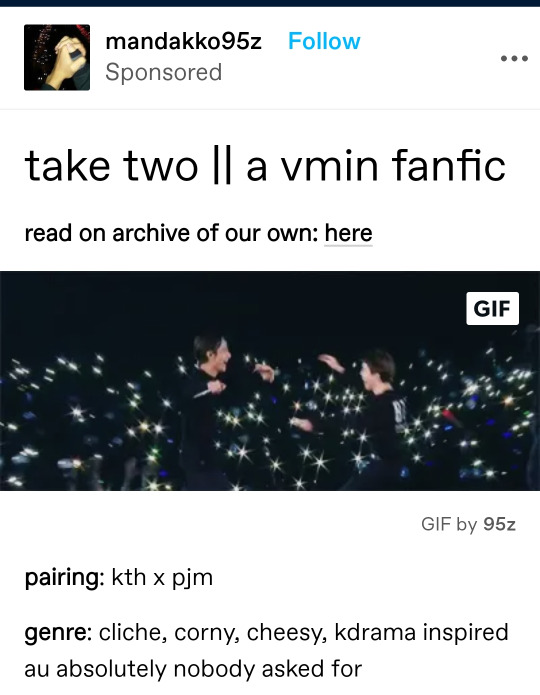

Maybe it's because I refuse to update my app so these might just by blazed posts but if not . why am I getting ads for bts fan fiction and bnha cosplays
#????#I'm so confused#no hate to the users btw I just don't know how they got on my dash#ads#sponsored#i wasn't even a vmin enjoyer when i DID like bts#nor do i like mha#get it together tumblr your record of me is looking pretty obsolete
3 notes
·
View notes
Text
lmao
'People are panicking about AI tools the same way they did when the calculator was invented, stop worrying' cannot stress enough the calculator did not forcibly pervade every aspect of our lives, has such a low error rate it's a statistical anomaly when it does happen, isn't built on mass plagiarism, and does not obliterate the fucking environment when you use it. Be so fucking serious right now
#do you realize how stupid you'd end up becoming by using AI?#1. you wouldnt be able to handle constructive crit#2. You'd lose your meaning of life#Creating is FUN. Its supposed to be FUN. Its one of the few things you look forward to after a long day of work#And what? You want to take ideas from a machine that will take the art pattern most commonly found and copy THAT?#WHERES YOUR ORIGINALITY MAN#calculators are fine. They only replaced quick math calc skills#Audio recorders are fine. They made shorthand obsolete#Computers are WAY fine. I can now talk to my mutuals and friends online that are def on the opposite sides of the world#But AI?#really?#The random knucklehead of a machine that spouts your essay for you while you do other things?#YOU WOULDNT EVEN LEARN TIME MANAGEMENT#OR HOW TO PRIORITISE#OR WHAT ON EARTH MATTERS THE MOST TO YOU#urgh screw AI#No one wants to pay people cuz broke#If everyone wants free stuff and its all cuz capitalusm#Doesnt allow you to#Then maybe we should go back to the barter system just sayin
93K notes
·
View notes
Text
Buck Curran — Delights and Dangers of Ambiguity (Improvisations 2017-2022) (Obsolete Recordings)

Delights and Dangers of Ambiguity (Improvisations 2017 - 2022) by Buck Curran
Delights and Dangers of Ambiguity is an outlier in Buck Curran’s catalog, in that it is a collection of improvisational experiments. Even still, there is a tie that binds these tunes to Curran’s overall oeuvre: a focus on resonance. Throughout his career — whether with his ex-partner Shanti as Arborea or on his own — the artist, multi-instrumentalist and luthier explores ways of extending a note’s sonic envelope via extended techniques. This has led Curran, who drinks from the overflowing Takoma School cup and draws influence from blues-influenced folk music, to align himself with the psychedelic folk scene of the northeastern United States. With this song cycle he strays from both orbits, instead carving a path through dissonance and darker hued textures. Curran is searching within his shadowy side, poking at unexplored pockets of his psychic apparatus, revealing an instinctual drive toward the polychromatic.
While Curran commonly employs the guitar in his arsenal, he’s also adept at the piano. He demonstrates his ivory tickling skills on the title track, a brooding modal piece that balances dark and light tones. The alien timbres of the piano suggest implements within the strings of the instrument. Curran propels swarms of buzzing melodies into the air and sears strange glyphs across the visual field. This synaesthesia is common across his body of work. Curran’s particular brand of psychedelia does not require any substances; his music itself opens the mind.
Curran is a serial collaborator, and some of these pieces find him selecting friends and confederates with whom to jointly experiment. On “Gemini Sun, Gemini Rising,” he enlists the help of cellist Helena Espvall (Espers, Anahita), who was a regular Arborea associate. The pair coax writhing phantasms from their strings, with Curran’s guitar producing intertwined streams of uncanny melody across Espvall’s arco environments. Composer Hiroya Miura lays down a delicate and impressionistic piano passage on “Mugen no Umi no Iro.” Curran fights not to overpower the sprightly tinkling, instead choosing to dissolve into the background so that Miura can shine. Eventually the pair seem to lock horns in a subtle dance of keyboard and guitar. “Slow Air” is a short folk guitar tune accompanied by organ drones from Jodi Pedrali, an Italian musician; Curran currently lives in Bergamo with his wife and kids.
Some of these songs are centered on lyricism rather than dissonance. “Prelude in D Minor” roots itself in an evocative piano melody before diving down a rabbit hole of guitar drone, while the ultra-short “1894 (Coda)” eschews the guitar altogether, instead focusing on a hypnotic keyboard passage with notes that ring out to infinity. Resonance and sustain are never far from the core of all these pieces. Curran toys with these concepts, turning them over in his mind and creating sonic microcosms. We’re fortunate to imbibe the tasty auditory brew that results.
Bryon Hayes
#buck curran#delights and dangers of ambiguity#obsolete recordings#bryon hayes#albumreview#dusted magazine#improvisation#guitar
3 notes
·
View notes
Text
the older I get, the more the technological changes I've lived through as a millennial feel bizarre to me. we had computers in my primary school classroom; I first learned to type on a typewriter. I had a cellphone as a teenager, but still needed a physical train timetable. my parents listened to LP records when I was growing up; meanwhile, my childhood cassette tape collection became a CD collection, until I started downloading mp3s on kazaa over our 56k modem internet connection to play in winamp on my desktop computer, and now my laptop doesn't even have a disc tray. I used to save my word documents on floppy discs. I grew up using the rotary phone at my grandparents' house and our wall-connected landline; my mother's first cellphone was so big, we called it The Brick. I once took my desktop computer - monitor, tower and all - on the train to attend a LAN party at a friend's house where we had to connect to the internet with physical cables to play together, and where one friend's massive CRT monitor wouldn't fit on any available table. as kids, we used to make concertina caterpillars in class with the punctured and perforated paper strips that were left over whenever anything was printed on the room's dot matrix printer, which was outdated by the time I was in high school. VHS tapes became DVDs, and you could still rent both at the local video store when I was first married, but those shops all died out within the next six years. my facebook account predates the iphone camera - I used to carry around a separate digital camera and manually upload photos to the computer in order to post them; there are rolls of undeveloped film from my childhood still in envelopes from the chemist's in my childhood photo albums. I have a photo album from my wedding, but no physical albums of my child; by then, we were all posting online, and now that's a decade's worth of pictures I'd have to sort through manually in order to create one. there are video games I tell my son about but can't ever show him because the consoles they used to run on are all obsolete and the games were never remastered for the new ones that don't have the requisite backwards compatibility. I used to have a walkman for car trips as a kid; then I had a discman and a plastic hardshell case of CDs to carry around as a teenager; later, a friend gave my husband and I engraved matching ipods as a wedding present, and we used them both until they stopped working; now they're obsolete. today I texted my mother, who was born in 1950, a tiktok upload of an instructional video for girls from 1956 on how to look after their hair and nails and fold their clothes. my father was born four years after the invention of colour televison; he worked in radio and print journalism, and in the years before his health declined, even though he logically understood that newspapers existed online, he would clip out articles from the physical paper, put them in an envelope and mail them to me overseas if he wanted me to read them. and now I hold the world in a glass-faced rectangle, and I have access to everything and ownership of nothing, and everything I write online can potentially be wiped out at the drop of a hat by the ego of an idiot manchild billionaire. as a child, I wore a watch, but like most of my generation, I stopped when cellphones started telling us the time and they became redundant. now, my son wears a smartwatch so we can call him home from playing in the neighbourhood park, and there's a tanline on his wrist ike the one I haven't had since the age of fifteen. and I wonder: what will 2030 look like?
32K notes
·
View notes
Text
So about the Battle Subway Trains

Hi, I love trains! And the Trains in Unova have a surprising amount of detail? And nobody talks about it? And if I don't talk about it I will explode!?!!!
So despite Unova being inspired by New York you'd think the Battle Subway Trains would be based on The New York Subway Trains? However they look like they are more based on Japanese Railway Trains!
I'd like to preface before going into this that despite talking a lot about the Japanese Railway, I am not Japanese, while I did my best to research as best I can, some stuff may fly over my head, I also used an online translator for some information so it might not be 100% accurate.
Alrighty lets get into this! This is mainly for fun and its going to be under the Read More because it is verrrrrrrrry long, I hope that you enjoy!
If you aren't aware, each train in the Battle Subway has lore! All the lore comes from this Worker NPC on the bridge in Anville Town. Depending on the day, a different train will show up on the turntable, and he'll give you a little dialogue for that train! This dialogue is what I'll be mainly analyzing :]

Single and Anville Town Trains:


"This is a Single Train! It's the oldest train in the Battle Subway. It's for a loop line to go around the Unova region! Do you know Tubeline Bridge? The train that runs on it is this Single Train."
"As you know, this is a local train to Anville Town! Isn't it just so cute? This one is a little slow and heavy. When it runs, the whole train sways. The train car is the same model as a Single Train. Because it is an old train car, I hear the maintenance is hard, but it's the one I always ride, because I loved it as a kid!"
So! The Single and Anville Town Trains are the same model of train, you can actually see this in their designs where they both share the same face but they differ in the livery. (Livery is a term referring to the train's decor/color, the color is often associated with a particular company or in this case a particular train line.) I'm going to use this fact to assume that if one train has one feature, then it's likely that the other train also has that same feature. Such as how the description of the Anville Town Train says it sways as it runs, if that is the case then the Single Train also probably sways. (which sounds kind of awful to battle on, unless you have good train legs I suppose X_X)
It is stated that the Single Train is the oldest in the Battle Subway. I believe though, that it means the oldest train that is currently running in the Battle Subway. As there is another train that seems much older and no longer running, but I'll get to that train much much later.
Older trains are indeed harder to maintain, and expensive too. This is because the older the equipment, the harder it is to get its parts as they become more obsolete. Though I will say this, trains can last a long time! The average service life of a train is about 30-50 years, it really varies from train to train. These trains would most likely be on the older side.
There is a slight possibility that it has been continued to be maintained past it service life. Given how fond the Worker NPC talks about the train, it might have high sentimental value. Therefore if it is past its service life, it has not been scrapped or recycled yet because of it. I doubt this is the case though, usually it is never worth the maintenance cost (especially for regular operation.)
Like the description says, you can see the Single Train running on the Tubeline Bridge, here's a video of it! Apologies for the way I am recording this, I don't exactly have a capture card, but I wanted to show you guys regardless
You can see how fast the train is going as it passes below you! At least the just Singles Train anyways, seems to me like it's going about 20-30mph? I tried doing math to find the exact speed but that's difficult for several reasons (no idea how large a "tile" in Pokemon really is and objects in the overworld are not very accurate in size so I can't exactly do any comparisons. The perspective of the camera also makes it tricky.) Given how the Anville Train is described as "slow and heavy", I would hazard a guess to say that the other trains of the Battle Subway may run faster than this.
You can also see that each train is made up of 7 cars as it passes below you if you slow down the footage. Which is not surprising, you have to win 7 battles in a row to complete a "set" where you are then dropped off at a rest stop. I believe the Battle Subway trains to be electrical multiple units (EMUs) so it would probably make them 7-car sets.
It also looks like the Singles Line is very busy with the trains only being seconds apart! Now I know this is more a visual thing so the environment would be interesting to look at, but I'd like to think it indicates that the Battle Subway/Singles Line is very popular! (and very well organized!)
As for Real life train inspirations I think perhaps the Tobu 10030 series?
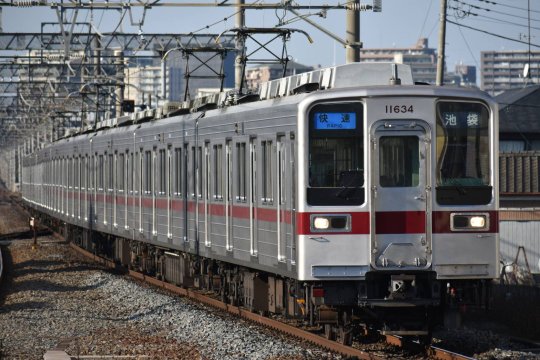
The Tobu 10030 is a version of the Tobu 10000 series with some minor changes, such as the design of the face and using a bolsterless bogie. (Bogie is a part of the train that refers to a frame that holds sets of wheels as well as the suspension, breaks, etc. in which the body of the train car rests upon.)(A bolster is a part that connects the side frames of the bogie and the underside of the car's central pivot point.)(A bolsterless bogie is a bogie type that doesn't have a bolster). The front of the train is covered in fiber reinforced plastic and the outer panels are "bead molded" (which... I have no clue what that means...) This series has been going under renovations since 2010.
Double Train:

"This car is a Double Train! This is a mass-produced car from a decade ago! Compared to a Single Train, the number of parts was reduced so it could be built for a lower cost. The number of parts influences the budget and construction time. The streamlined and beautiful design of the Double Train is still valued today."
So the Double Train is at least 10 years old! (That's what decade means!) Honestly though, I think the Double Train might be older than 10, in Japanese the description just says that it is a "mass-produced train from a long time ago" and doesn't mention a number... Another reason is that in the Multi Train description, it mentions that it is a test model for future trains that will replace the Double Trains. Which means perhaps that the Double Trains may be reaching near the end of its service life, which again average 30-50 years. It could be a possibility that this train may have a shorter service life than usual, who knows. This all speculation really.
As for lowering the amount of parts, from what I found it makes the train lighter. It would also probably lower the cost as well like the description says (trains are really really expensive to build! EMUs can cost $2mil-$10mil per car!)
It also mentions that it is a mass-produced car! It's a train made with mass production for commercial purposes! I believe it's usually for train lines that are really busy, where they would need a lot of trains? It typically means that there are a lot of them. (All this makes me wonder about train production in the Pokemon World...)
As for Real life inspirations, I think that the Double Train is inspired by the Tokyu 1000 series train.
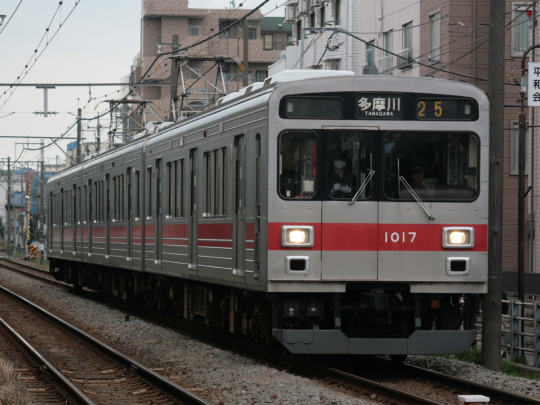
The Tokyu 1000's design and equipment is similar to another train, the Tokyu 9000 series, with improvements such as improved handling and making it easier to do inspection and repair work. As well as reducing the amount of spare parts from the Tokyu 9000.
Multi Train:

"This car is a Multi Train! Few cars of this model were produced. This is a test car to develop future mass-produced cars that will replace the old Double Trains. The technology born during the creation of this train car made the Super Single Train and Super Double Train possible!"
The multi train is a test/prototype train! A little surprised that an entire line is running off a few prototypes. Like the description says, not many are produced as the purpose of a prototype is to test features and improve upon them if needed before they are put into mass production. Given that it says the technology from this train was the reason the Super Single and Super Double Train was made possible. I'm thinking it was most likely testing some eco friendly features? As it is the Super Single and Super Double Train's main feature.
Perhaps them using a model with so few trains means that the Multi line isn't that busy/popular? (Surprising then the train platform is not swarming with more train photographers haha!)
As for real life inspirations, while the livery may not be the same I think it could be the Keisei 3000 (2nd Generation.)

The Keisei 3000's body is made of lightweight stainless steel and the passenger doors have a paper honeycomb structure. When they were designing this train, they wanted it to be both environmentally (energy saving) and customer friendly (being accessible to elderly and those with disabilities.)
Super Single and Super Double Trains:


"This Super Single Train is a new mass-produced car! It's an environmentally friendly train, because they revised all the parts to drastically reduce power consumption! Newer trains have to be built in a way that's both functional and environmentally friendly. Compared to the past, they've improved significantly."
"This Super Double Train is a new mass-produced car! Such a streamlined and refined design! Beauty and utility working together! That kind of beautility is unique to mass-produced train cars! It uses the same train car as a Super Single Train. The only difference is the appearance. It is a superb train car that will go down in the history of the Battle Subway!"
The Super Single and Super Double Trains are the same model. Honestly the description of these trains doesn't give me a lot of information besides the fact that these trains are eco friendly. So I'll talk about what trains do to make themselves (even more) eco friendly!
They are stated to be eco friendly by reducing power consumption. I think it could be referring to a "VVVF inverter control" (it stands for variable voltage variable frequency. In English its mainly called the VFD or variable frequency drive.) A VVVF is a type of system for an AC motor that can reduce energy consumption! (There are two types of electrical current, DC or Direct Current and AC or Alternate Current. An AC motor is a motor that is driven by AC electricity.) It is important on energy saving trains! I won't get too much into how it works, but essentially it controls the AC motor's rotational speed by controlling the frequency. By controlling these, it can control the speed and acceleration of a train. You'll find that a VVVF is often paired with a three phase motor (I will not go into that...) Let's just say that these systems are very efficient at using power and help save energy.
Really, reducing power consumption usually means being more efficient at using power. Like using LEDs, using better insulation to retain cooling or heating, and generally using parts that use less electricity. It could be that the train is lighter in weight too (lighter vehicles use less power.)
Both of these Super Trains are mass produced! Which tells me that there are a lot of Super Single and Super Double trains! Its lines are probably busy.
As for real life inspirations, it is very much inspired by the E233-2000 series train

The E233-2000 is a little bit of an oddball in the E233 family exterior design wise. Its design was inspired by the Tokyu 5000 series. Its basic running equipment is the same as the E233 trains before it though.
I think it is a bit of a stretch, but I'll mention it anyways. The E233 (which the E233-2000 is a subsection of) is a train that has won the Laurel Award in 2007. The Laurel Award is an award given to trains by the Japan Railway Friends Association for trains with an excellence in technology and design (specifically geared towards commuter trains.) It could be what all the "beautility" comments could be referencing to? They do look verrry different though, and the E233-2000 came after the award was given...
Super Multi Train:

"This train car is a Super Multi Train! This is the latest train car! Improved acceleration and deceleration! Automated train-car controls! It's full of cutting-edge technologies. Also, a regeneration brake system, a car-body tilting system, a whatchamacallit system, a thingamabob system... I don't remember all the details, but it's just a big festival of all the latest technology!"
Ohhoho! The Super Multi Train description is a goldmine of details! This train is the whole reason I wanted to make this post! Let's run through its features!
Improved acceleration and deceleration means that it can run between stops faster, allowing for quicker operation time.
Automated train-car controls or ATC is a safety system on trains that prevents trains from going over a certain speed! If the train goes over the maximum speed permitted then the ATC will pull the brakes automatically to reduce the speed and release the brakes when it is below maximum speed. It also displays the maximum speed to the driver. It is an incredibly important safety system!! From what I understand, the term ATC is very common in Japan, in other countries the ATC would simply be a part of cab signaling (it is a safety system mainly for the driver and train crew, it tells them track status and condition information) and train protection technologies. ATC is installed on all Shinkansen trains, it is also installed in some subways and heavily used railways.
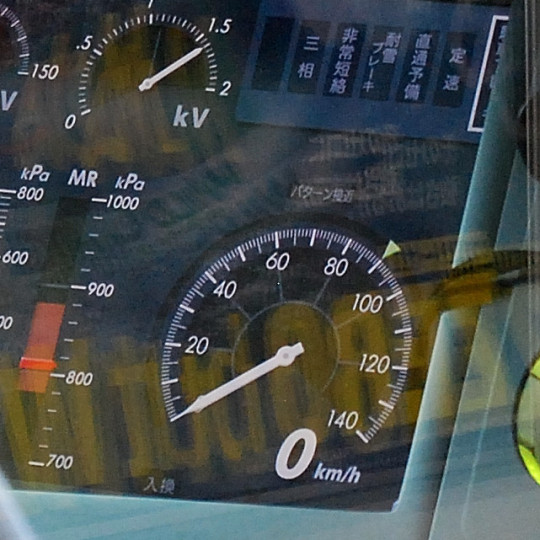
Here's an example of what it looks like! The green triangle there is the (current) maximum speed. There are a lot of different types of ATC systems and this ones a D-ATC (stands for Digital Automatic Train Control) from within an E233! There are a whole lot of different types of ATC, and they can come in many looks! I would show more examples, however, I have hit the image limit on this post... :[
A regenerative brake system is a special type of breaking that allows a train to generate electricity via breaking! The electricity can either be used immediately, stored, or returned back into the line. You might've heard this feature on electric or hybrid cars. It is a common eco friendly feature!
A car-body tilting system is a feature in trains that allows the body of the train car to tilt into a curve! It allows the train to go faster on a track (not needing to slow down on a curve) but the feature is mainly for passenger comfort! When you ride, you don't feel the centrifugal force at all when going around a curve! And it makes the ride so smooth! Here's a short video demonstrating what it looks like:
youtube
There are essentially two major ways to do a car body tilting system. There is active tilting (forced body tilting) or passive tilting (pendulum system). A forced body tilting system uses computers to tilt the train using track data or sensors, telling the train when and how much to tilt. If the calculation is not done correctly, it can leave passengers with motion sickness (An infamous example is the Advanced Passenger Train in the UK). The tilting itself I believe is done via hydraulics. Forced Body Tilting is more popular in European and American trains.
As for passive tilting, the train in the video uses it! (A controlled pendulum train!) It means it uses natural forces to tilt the train car. I'll dive deeper into this type of tilting in the Wi-Fi train section because it actually mentions it's a pendulum train! As to which tilting type the Super Multi train has... it could honestly be either.
(Ah! I forgot to mention this, but tilting trains are especially useful in mountainous regions, where there are a lot of curves.)
In the Japanese version of the Super Multi description, it also mentions that it has a "earthquake warning system" and a "tornado monitoring system".
An earthquake warning system is not something fully installed into the train, rather it's mainly a set of sensors installed along the track, coast, and major inland areas. For passenger rail, if any signs of an earthquake are detected, it will alert any trains in the affected area and drivers are required to apply their emergency brakes. For shinkansen trains it will cut off power to the affected area which will automatically activate the emergency brakes.
Well, I found something close to a tornado warning system. There is a "gust warning system" where sensors measure wind speed and to predict where strong gusts of wind would go. Again, it's not a system that is installed within the train. From what I could tell, they would restrict travel speed during strong winds. If wind speeds are too high, then they would shut down the lines. (I suppose would be very useful, especially when there's some legendaries that cause powerful storms roaming around.)
In the Japanese version of the text, it also states that the Super Multi Train is also a test train. Which again means there's also not a lot of this train. It also states that some of it's features are unnecessary due to it being a test train lol
In the description all these features are stated as "cutting edge" and "a festival of all the latest technology" when these features are not all that new? And Regenerative breaking seems to be pretty common? (Every irl train I have shown thus far all have it.) Eh, I don't think it's that big of a deal. They are just fictional trains after all.
I originally thought the train looked like an Eizan Railway Deo 800 series, but thanks to the leaks, it looks like that the JR East 205-500 was used as a base to design the Super Multi Train? With probably heavy modification to the final design. (While I don't condone the method that these leaks were obtained, curiosity did get the better of me. This is the only train that I ID-ed this way.)
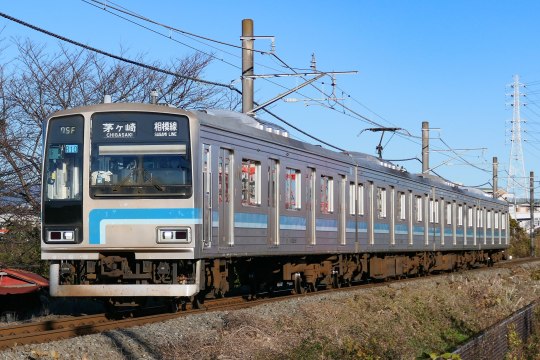
This Train was exclusive to the Sagami Line, though it ended operation in 2022 and every one of these trains have been scrapped. The blue color I believe is an homage to the Sagami River that runs along the line. The Train used a semi automatic door system for its passenger doors. Which means that rather than the conductor opening and closing the doors, the passengers would press a button to open the door when the train has stopped.
Wi-Fi Train:

"This train car is a Wi-Fi Train! It is the fastest long-distance high-speed train in the Battle Subway! This is called a pendulum car. Its body tilts while going around curves, so it can run without slowing down! Faster! Farther! Our engineers' spirits are infused in it!"
A pendulum car is a very specific term!!! Like I mentioned in the Super Mutli Train section it is a type of car body tilting. There are multiple types of Pendulum systems, There is Natural Pendulum, Controlled Pendulum, Air Spring (also called Simple Pendulum), and Hybrid.
Natural Pendulum is just using the centrifugal force of when it goes around a curve to tilt the train. This type was known to cause motion sickness in riders because when it straightened out, the car would "lag" or wobble. Sometimes the force was not enough to tilt the train and this would also cause passenger discomfort. These issues were fixed later with a controlled pendulum, where there would be a degree of control to the tilting. Using mechanisms similar to forced body tilting, it would prevent wobble and ease the tilt. The air spring method, as suggests in the name, uses air springs to help with tilting. It is similar to the controlled pendulum, though it tilts less than it (controlled pendulum can tilt 6 degrees and air springs can only tilt 2 degrees). Air springs are cheaper to build though and still are able to make the train go faster. Hybrid is the combination of controlled pendulum and air springs, allowing for an 8 degree tilt.
I hope the Wi-Fi train is not a natural pendulum? You're telling me you have to battle on that and you might get motion sickness?? Though it sounds like it might be more high tech so it is most likely the other types... Hopefully...
It also states that this train is the "fastest long-distance high-speed train in the Battle Subway!" Looking at Japan's tilting trains (that are not shinkansen), they go about 120kmh-130kmh (about 75 mph-81 mph.) So it could be a possibility that the Wi-Fi goes something along those speeds.
I've looked through Japan's tilting trains, and the closest one might be the JR Hokkaido Kiha 201 series? It's not at all close though... I can't really find a good match tbh. I think the 113 series seems to be a bit more closer visually.

The one on the left is a Kansai livery and the right is a JR Shikoku livery. They are both the same train, JR Shikoku bought the 113 series from JR East to replace some aging trains and then modified it. Which is why they look a bit different. The modifications include strengthening the front of the train and adding shock absorbing material inside.
So Those are all the trains that run in the Battle Subway! However there are 2 trains that don't, instead they only show up in Anville Town on certain days. I'll be calling them "Old Train Car" and "Futuristic Train Car"
"Old Train Car"

"This train car is the kind that ran a long time ago. Compared to contemporary train cars, it has more parts, so I heard it was difficult to build. The old train cars built with lots of small parts have their own unique beauty and attract a lot of fans. Those cars no longer run in the Battle Subway, but I hear they're still used in a faraway region. Ah... I'd love to be on that train!"
So this sort of car used to run on the Battle Subway. It's said to be still running in another region, though with how old the train looks I can only think that maybe it would be running by railway preservationists.
The design of this train reminds me a lot of old Japanese electric trains and trams. Especially trams with that double roof. I don't think it's really based on any particular vehicle? Here's a couple that I found;

The only one I feel like is worth mentioning is the Jomo Electric Railway Deha 101 (this specific car is the Deha 101, others of its kind are called Deha 100 type) and the Nagasaki Electric Railway 160 type. Both of these vehicles I believe are still running to some capacity.
The Jomo Deha 101 has been running for over 90 years. While car 101 still resides at Jomo Railway, other Deha 100s have been transferred to other private companies where they have been scrapped. I believe the only existing Deha 100s today are Car 101 and Car 104 (which has been painted bright yellow.)
The Nagasaki Electric Railway 160 type used to belong to the Kyushu Electric Tramway where it was called the Type 1 Electric Tram. When it was transferred to the Nagasaki Electric Railway it was renamed into the 160 type. Today, there is a single car in operation. I believe it is the oldest wooden car in Japan that is still in service.
I suppose I will also mention the Keifuku Electric Railway Mobo 21 Type Train, it does look the most similar. Though, it's purposefully designed to look like an old style tram.

"Futuristic Train Car"

"This train car is a new train to run in the future! Wooo! Cool! Super cool! The latest motor breathes fire! Uh-oh, if it really breathed fire, that would be bad! But it is full of the latest technologies! It's undergoing a lot of testing. It's called a gauge-convertible train. It's a sweet car that can adjust its wheels to run on any rail!"
So first off, I'd like to say that this train visually kind of looks like a "Sonic" 883 series (nothing to do with the blue hedgehog, it was just a coincidence lol)

However the description!!!! A "gauge convertible train" that is undergoing a lot of testing... That description matches exactly with the GCT! (literally standing for Gauge Change/Convertible Train, though in Japanese it's called FGT or Free Gauge Train!)
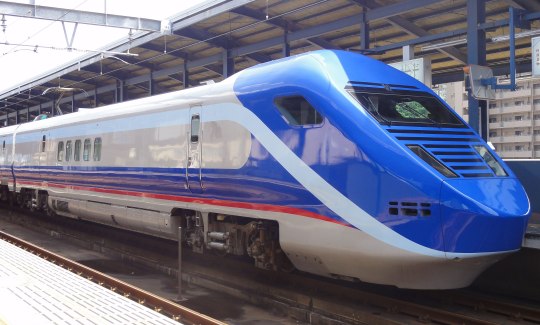
The GTC is the project name for this experimental shinkansen. The one in the picture is the GTC-01, the second generation of its kind (as this is the version they would be testing before and during the development of the game, there is now a 3rd generation.) So, the term gauge refers to the distance between the two rails. Different trains run on different gauges, they can come in either narrow gauge, standard gauge, or wide gauge. Japan's rail network is mostly narrow gauge (specifically Cape Gauge.) The main exception are the shinkansen trains, which run on standard gauge. This shinkansen like the description says would be able to run on any gauge. It used to be under a lot of testing by the Free Gauge Train Technology Research Association. Today though, the GTC-01 second generation sits on display in the Shikoku Railway Heritage Museum.
There are a lot of challenges that the GTC faces. It takes a bit of time for the wheels to adjust to the gauge and you need to go slower when it's doing so. It has increased maintenance costs. The heavier specialized bogie creates more wear on the rails as well as making the train harder to detect. (Ok! Basic explanation for Railway Signaling! Tracks are split up into sections called "blocks", and a small electrical current is run between the two tracks that makes up the block. When a train runs through, the wheel and axle of the train disrupts the current, which then the system detects that block as being occupied by a train. If it is occupied, the signal lights at the end of the block will be turned red, preventing other trains from entering the same block, thus preventing collisions. The problem arises in the GTC in that the wheel and the axle are separate, thus something about this is making it hard to detect on the rail.)
With this train being a "gauge change train" it really made me wonder what gauge the Battle Subway trains runs at? I thought maybe standard gauge or maybe even wide gauge because you can only make the train so wide depending on the gauge. And you'd probably want it wider so that there is more room, especially if you are fitting a battle arena in it! However in Japanese the description mentions that "The rails are a little wider on the tracks that run at higher speeds." Which is... exactly how Japanese rail works? So the Battle Subway lines are probably narrow gauge?
Another thing that's interesting about the "Futuristic Train" is the date that it actually shows up. In Anville Town the way that each train shows up is dependent on the last digit of the day of the month, like so:
0- (10th, 20th, and 30th) "Old Train Car"
1- (1st, 11th, 21st, and 31st) Single Train Car
2- (2nd, 12th, and 22nd) Double Train Car
3- (3rd, 13th, and 23rd) Multi Train Car
yada yada you get the point (4- Super Double Train, 5- Super Single Train, 6- Super Multi Train, 7- Anville Town Train, 8- Nothing, 9- Wi-Fi Train)
The only exception is the "Futuristic Train" who will show up ONLY on February 1st, June 12th, October 1st, October 14th, and December 30th, pretty random huh? haha of course not! These dates are dates significant to the History of Japanese Railway/Transportation!
February 1st: The opening of Japan's first electric street car in 1895!
June 12th: The temporary operation of Japan's first passenger railway in 1872!
October 1st: The release of Japan's first Shinkansen, the series 0 in 1964!
October 14th: The official opening of Japan's first passenger railway in 1872, with the first two stations between Shimbashi and Yokohama! This day is also Railway Day in Japan, celebrating this event, Tokyo holds a Railway Festival and train companies like to do events on this day as well!
December 30th: The opening of Japan's first subway line in 1927, The Ginza Line!
Rails, Station Platform, and More Train:
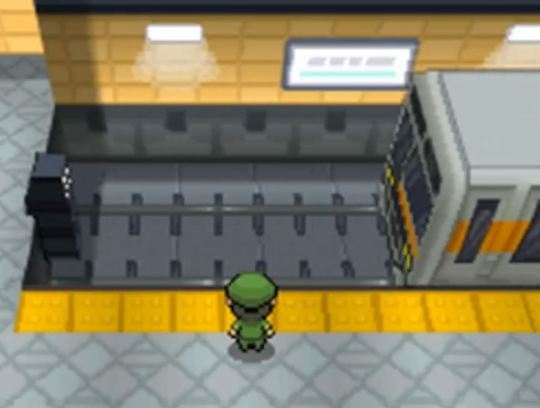
So the Station, there are a few details I can pick up on here!
The type of track that the trains run on (at least in the station) are ballastless tracks! It means the rail is tied directly onto a slab of concrete rather than having ballast hold it up (ballast is that rocky gravel that you often see beneath the tracks.) This type of track is quite expensive to build and makes the place a lot nosier, but it has a lot of advantages! For one, because there is no ballast to maintain, it has lower maintenance cost (ballast must be packed every now and again using a ballast tamping machine. Which lifts the track and jostles the ballast beneath it. Ballast also needs to be replaced after a while because the rocks have to be irregularly shaped for it to work, and natural weathering can make them smooth out.) It is also easier to clean and has a longer lifespan. Because the rail is tied to slabs of concrete the rails are less prone to deformation, which is good! Though it is also that same inflexibility means that it is difficult to change anything about it and takes longer to repair.
Their buffer! (that little black thing at the end of the line, I think it is a buffer?) It doesn't look like that effective of a buffer... The purpose of a buffer is to stop a train if brakes fail. Though this thing seems to be more for the driver telling them where the end is, hence all the, what I presume are, lights. Let's hope they have some sort of other safety system in place.
There doesn't seem to be a third rail. I have a feeling that might be because most Japanese railway trains are powered via overhead wire (literally every irl train I have shown is powered this way.) Maybe the Battle Subway trains might be powered via overhead wire? I might be over analyzing here, they might not have thought of modeling such a small detail haha

The train itself has some sort of device on top (that box thing.) I believe it to be some sort of air conditioning unit. Given how each train car has one large unit on top of it, I believe that it uses a centralized cooling system, which means there is one large air conditioning unit. (There are 2 other types, they are distributed cooling which consists of 6-8 small units and centralized distributed which consists of a couple of medium sized units.) Central cooling systems are easier to install and maintain because there is only one unit to worry about.
Signboards:
The Buildings in between routes have a electronic news bulletin board, and depending on which city is connected to it, the news bulletin will give a little flavor text about the city. There's some flavor text about the Battle Subway when it's about Nimbasa City, and it different depending on whether you are playing the first one or the second one, here they are:
BW
"Run and battle! Trains never stop!” Battle Subway in Nimbasa City"
"They say someone who loved battles also happened to be a railway maniac, and thats why we now have the battle subway"
So, this might be a coincidence, but there is an old name that Japanese Train Fans used to call themselves. The name was "Railway Mania" (鉄道マニア direct translation). It was used up until the 1950s. Today it's seen as a derogatory term but it was used very commonly back in its heyday (even more popular than "railfan" apparently.) I think it is kind of interesting that the term "Railway Maniac" was chosen for this flavor text and I wonder if it has anything to do with this old name. However, I say it might just be a coincidence because the term "Maniac" is not unheard of word in Pokemon (Item Maniac, Poke Maniac, Hex Maniac, etc.) But regardless, there's that little fun fact for you!
B2W2
“Get on a train and fight!” Battle Subway in Nimbasa City"
"The energy generated by heated Pokémon battles is the fuel that keeps the Battle Subway running"
I'm going to get a little headcanon-y here. We can interpret this figuratively, as in if there are no battles then its not really a Battle Subway is it? But I think it would be fun to interpret it literally! What if Pokemon Moves could get absorbed somehow to power the Train? And if the Train doesn't need it it could go into the line to power something else in the Subway! I think that would be cool :]
Extra Stuff:
●I think the Battle Subway Map could also be inspired by JR East's rail map, the main reason is the single lines (dark green) which goes in a loop around the Unova Region...

Reminds me of the Yamanote Line (light green) which also goes in a loop connecting a variety of major stations together in Tokyo and is a very very important line!

●While I do believe Gear Station is inspired by New York's Grand Central Station, I do think there's a lot of design elements taken from Tokyo Station as well
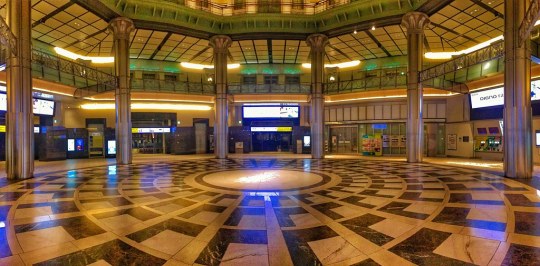
●The gray bodies of the Anville, Single, Doubles, and Multi cars are probably meant to represent an exposed steel/aluminum body rather than the ones painted white like the Super Trains.
●In the Anime, the trains are said to have an ATO system, this is also a real system, it stands for Automatic Train Operation. It's a system that allows a computer to control when the train stops and goes with no driver involved! I don't think that the trains in the games run on an ATO system though, as there are Depot Agents who talk about train driving (Depot Agent Cameron who says "I’m good at driving, but I’m not good at dealing with Pokemon." at the start of battle, and a way more obscure Depot Agent whom you can talk to on the platform after 14 wins on a Super Train who says "I’d rather have an exciting battle than slowly drive the train.")
●In the Anime, there's a stamp rally, which is a real thing! There are station stamps in Japan which tourists can collect. Though, occasionally Pokemon will collaborate with JR East to create a Pokemon Stamp Rally! The most recent is this Pokemon Horizons Stamp Rally promoting the show! Here's a map of what stamps you can collect at each station and the prizes you can get!

●In the Nacrane city library there is a book that mentions that Nacrane used to have steam locomotives running through it!
"This book is about the things you can ride in the Unova region, such as Castelia City’s cruise ship and Mistralton City’s planes. Before there were planes, locomotives carried people all over Unova. The railway in Nacrene City is a legacy of those lines." (B2W2)
What kinds of Steam Locomotives? I suppose we will never know, as we never see one in game.
●There's an Roughneck NPC you can talk to at Tubeline Bridge in B2W2 where he says
"Watch it! People use “railway fan” as a catchall term, but there are many types of railway fans! There are riding fans, detraining fans, station fans, train-car fans, schedule-table fans, picture-taking fans, recording fans, and more! Don’t go thinking they’re all the same!" (B2W2)
So in Japanese, Railway is Tesudo (鉄道, testu 鉄- Iron and do 道-Road) and a Railway Fan is Tesudofan, however fans will abbreviate to just Testu and stick what aspect of trains they enjoy with it, so like 乗り鉄 (Nori 乗り-Ride, 鉄-tetsu) as a Train Riding Fan, or 撮り鉄 (Tori 撮り-Taking a Picture, 鉄-tetsu) as a Railway Photography fan. There are a lot of these and the NPC does go over some! There's also Railway Modeling Fans (Fans who collect model trains and/or construct model railways), Collecting Fans (Fans who collect railway related items such as tickets or stamps), Operation Fans (Fans who like researching railway operation and equipment), Regulation Fans (Fans who like researching railway handbooks and laws and regulations that go into a railway), Simulation Fans (Fans who like playing train driving/railway management games), Artists/Writers, Urban Explorers, and Railway Preservationist (I gave up on the last ones lol). There are lots of ways to enjoy trains!
There's also the super specific terms of "Mama Tetsu" where a mother becomes a railway fan because of their children's interest or "Oyako Tetsu" where a child becomes interested in trains because of their parents.
●The badge on Ingo and Emmet's hats probably represents the logo for the railway company that they work for, while researching about Japanese Railway Companies, I noticed that they have a lot of circular logos, here's a handful:
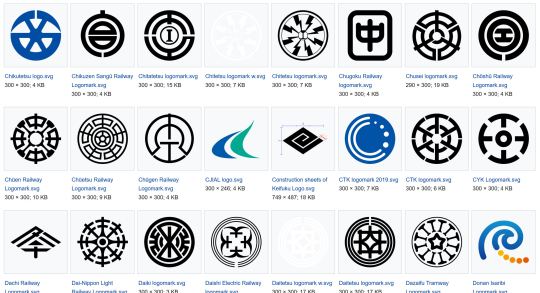
From what I could gather, these types of black and white circular logos are called a mon, kind of like a crest? If you wish to scroll about the logos, here is the link for the Wikimedia commons list.
The company's logo is also what's usually depicted on irl conductor's hats anyways, in the exact same place too.
(I was looking for a screenshot to showcase the hat to put here, but instead I found this promotional video! It's actually pretty good at going over the basics of what a driver and conductor actually do! Please feel free to check it out)
youtube
●The name "Depot Agent" is a little bit of a strange name, in Japanese the name is simply "Railway Worker", a depot is often referred to a train yard, however depot can also refer to a station, given where we see this trainer class working (at Gear Station), it is most likely that the depot in this case is referring to station, so they are station workers!
Final:
After all this I have come to the conclusion that somebody at Gamefreak really liked trains! And I really think all the little details are so awesome! and it really cements the Battle Subway as my favorite battle facility!
Anyways I hope you learned a thing or two and I hope you gained a new appreciation for trains and the Battle Subway! Thanks for Reading! ✌
(If I got anything wrong, please feel free to correct me, there was a lot of information I had to sift through and I am NOT an engineer * _ * and if you have something to add please do! I would love to learn more! ^ ^
#post#long post#VERY LONG POST#THIS TOOK SO LONG TO WRITE I STARTED THIS IN AUGUST#I love trains too much. Its a sickness really...#submas#battle subway#pokemon#pokemon black and white#pokemon black 2 white 2
2K notes
·
View notes
Text
"well youve had it 6 years that's a good amount of time for that kind of thing to work"
"you should be grateful you got 3 years of use out of that thing, I'm lucky if mine last a year haha"
listen, in 1977 nasa launched the voyager spacecrafts to take advantage of a planetary alignment that takes place every 175 years. These 2 crafts were planned to flyby the outer planets of our solar system and gather data on them to send back to us. Voyager 2 launched first on the 20th of August despite its name because it was planned to reach our gas giants after its counterpart voyager 1, which launched a little later on the 5th of September.
The voyager mission was planned to end 12 years later in 1989. In that time, voyager 1 and 2 passed by Jupiter, Saturn, Uranus, and Neptune. They discovered new moons, confirmed theories about Saturn's rings, found the first active volcanoes found outside the earth, and they take close-up images of planets only seen at that point from telescopes.
On the 25th of August 1989, voyager 2 encounters Neptune, the last planet in our solar system the voyagers will meet. And that was that. End of mission. Now obsolete.
~
Less than 1 year later on valentine's day in 1990 voyager 1 looked back on the planet that had built it and sent with it a world's worth of hopes and dreams and took a picture. We called it the solar system family portrait and in it, we see ourselves. The pale blue dot nestled in the darkness of space
And then commands were sent to shut down their cameras. Preserve fuel.
35 years after launch, in 2012 voyager 1 sent back to us data about interstellar space. The very first manmade object to enter it.
41 years after launch voyager 2 did the same. Still operational, still going. Still sending back to us invaluable data, teaching us about our own solar system and the suns influence in our local bubble of space.
They are expected to continue to operate until the year 2025 - almost 50 whole years after they were launched and 36 years after their mission was supposed to have ended.
48 years of harsh space travel, battered by solar winds, pulled by gravity but fast enough just to escape, pelted by who knows how much space dust and radiation.
And even after that, they still have a purpose. Each craft was given a golden record. A disc filled with human knowledge and knowledge of humans and the planet they live on. Greetings and well-wishes to any prospective extraterrestrial life that could potentially pick it up. Co-ordinates, an invite. Samples of our music, the things we love, sounds of the earth, a story of our world. The surf, the wind, birds and whales, images of a mother, our moon, a sunset. Long after the voyager spacecrafts go dark, probably long after we are gone, they will still be doing their job; educating a species about our very tiny corner of the galaxy.
They are nasa's longest-running operation.
And it was all done using 70s technology.
So excuse me if I want a phone that lasts more than 2 years or a vacuum cleaner that doesn't break down after 6, or god fucking forbid, a refrigerator that will keep my food cold my entire fucking lifetime.
#voyager space#voyager#voyager 1#voyager 2#nasa#planned obsolescence#capitalism#im sorry i took the opportunity to talk a little about the voyagers#they make me emotional okay#i just want things to last without breaking and then being sent to landfill#they did it in the fucking 70s#capitalism is not tenable and i cant afford to keep replacing the gadgets that broke for no other reason than they were built with shit
10K notes
·
View notes
Text
ironically enough, some people claim he stole his idea for the fountain from elsa von freytag-loringhoven. in my eyes that theory has been completely disproven due to those letters both being taken out of context and willfully mistranslated. but the fact that it could have been a stolen idea? what would that mean for the piece? would that mean it's not art? would that undo the influence it had on the art world for more than a century? theft does not negate art.
i personally don't like ai art, but i don't think that it's ontologically evil, or that it isn't art, because i believe anything can be art. the theft of living artists' work by these sites does make me uncomfortable, just as if duchamp stole the urinal from either freytag-loringhoven or from a pub, that would make him a bit of a dick. he'd still be an artist, though.
it’s awesome that we’re doomed to hear the same reactionary opinion that art is only art if the artist puts work into it for the rest of time
#the main reason i'm not anti ai art is bc the only meaningful action that can be taken to combat ai art is to expand copyright law. i'm for#the abolishment of copyright law bc i am for the abolishment of capitalism and copyright is intended to protect artists from exploitation#under capitalism. if we get rid of capitalism then we can get rid of copyright too. copyright law is so often misused by capitalist#corporations to the detriment of small artists and individuals. think abt YT's copyright system being shit. or how awful record companies#are. or how disney keeps remaking old ips of classic fairytales in order to keep the rights to those stories. expanding copyright will not#help you bc copyright already doesn't help you in our broken system. so if we get rid of our current system? then after that copyright#becomes obsolete. those are just my thought though. apologies if any of this is rambly. i just woke up and had to respond to this bc it#annoyed me lmao. great points as always nick!!
2K notes
·
View notes
Text

Revolutionary War Pension Files Seals ✒️🪙📜
Official American 19th century records have fascinating visual features and many remarkable examples of those can be found in the Revolutionary War pension files at the National Archives.
During the conservation stabilization treatment of these records, the conservators come across watermarks, ribbons, wood engraving illustrations, historical repairs, and of course various seals and wafers.
Guest Post by
Paper Conservator (Document Conservation Laboratory, RXC)
Ewa Paul (National Archives)
The term “seal” can be confusing because it refers to both the impression and the device which produces it. Early documents or letters were secured with resinous sealing wax impressed with a stamp seal and were reserved for officials or aristocrats. Later on, in the 19th c., the majority of the literate people used circular paste wafers and paper wafer seals which were much cheaper and easier to use. Wafers are “thin, flat, baked adhesive discs” made of flour paste. They would be moistened on both sides before being pressed to seal a letter or a document. Wafers came in different sizes and colors, and were used as adhesive joints or for affixing paper seals on official documents as shown below.

The wafer made from red colored paste is underneath the paper seal stuck on top. It is the same seal shown on white and blue wafer paper seal.
Sometimes the wafer paper seals would be made to purposefully emulate the appearance of the older wax / resinous seals as illustrated below (NARA records).

The paper seals found on the Revolutionary War documents vary in color, style and type and can have eye-catching, intricately carved designs.
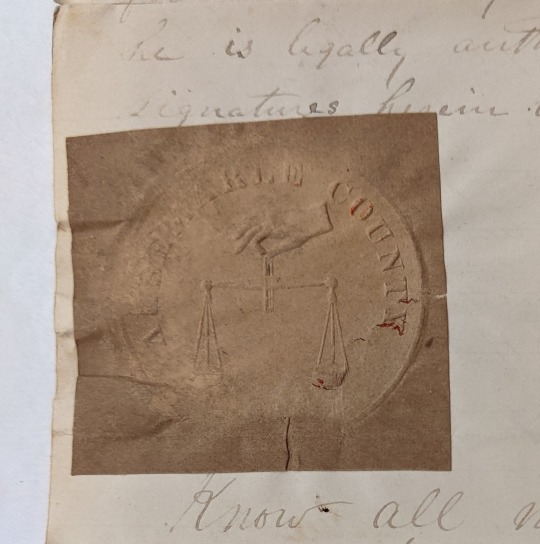
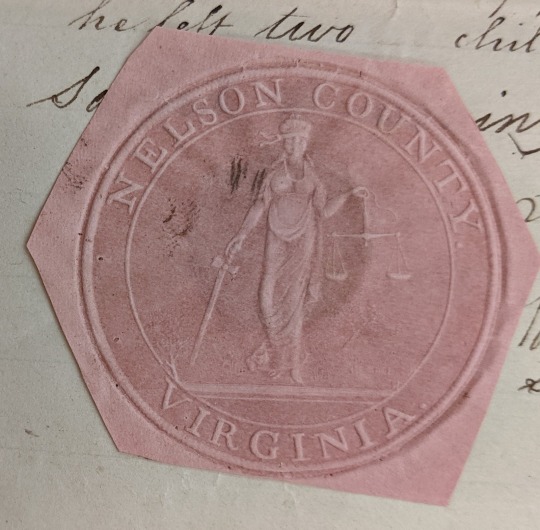
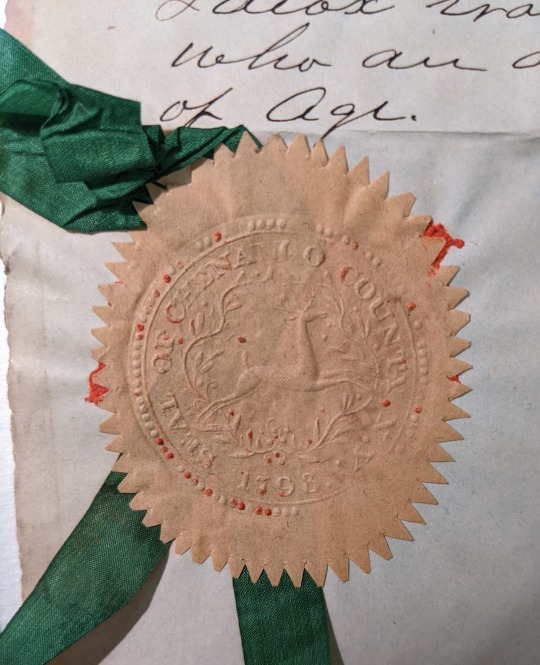
The Revolutionary War pensions records bear many types of seals: hand-written seals, ink printed seals, embossed paper wafer seals and “Scherenschnitte” hand-cut seals.
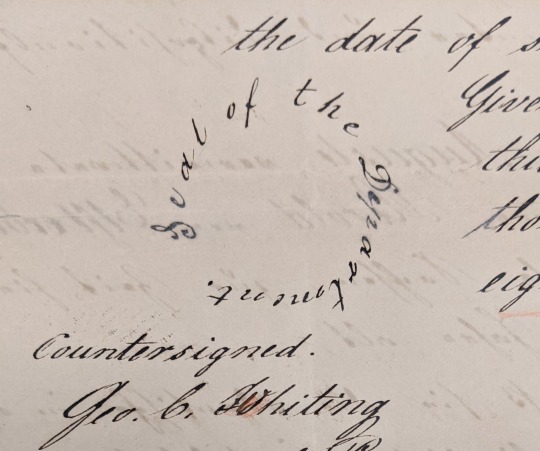
The image of the beehive in the inked seal above illustrates the importance of agriculture, as does the plough in the paper seal below, featured in the Revolutionary War pension file of James Scott, TN.
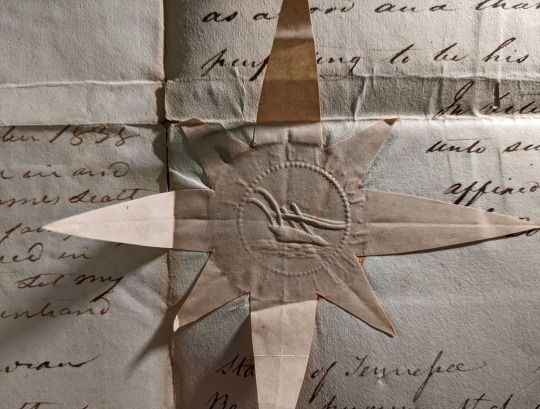
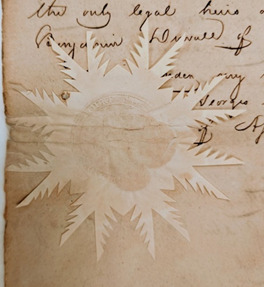
Hand-cut Scherenschnitte seals found on the American Revolutionary War pension records. Scherenschnitte paper seals are one of a kind. Scherenschnitte means “scissor cuts” and is a traditional folk-art brought to Pennsylvania in the 18th century by German immigrants.
As other methods of document protection became common, particularly the self-sealing envelope, the use of wafer paper seals declined and by the end of the 19th century the wafers and seals became obsolete.
These days the seals remind us about the importance of privacy and the need to guard our information, and how tricky it must have been to keep things private in the days past.
357 notes
·
View notes